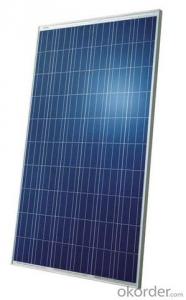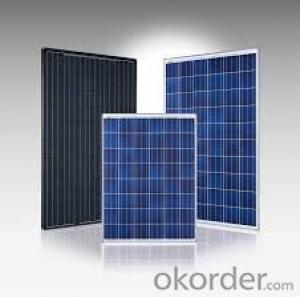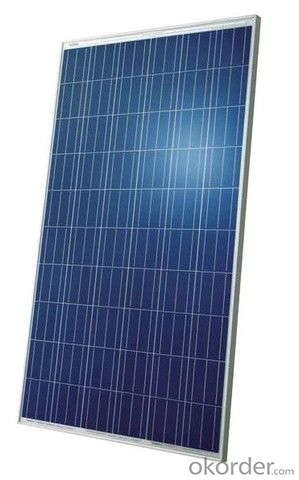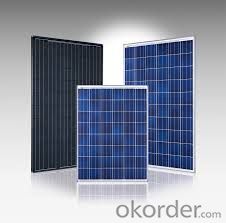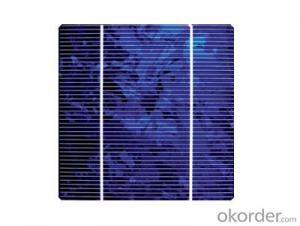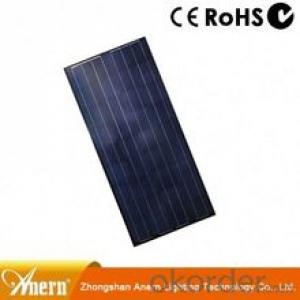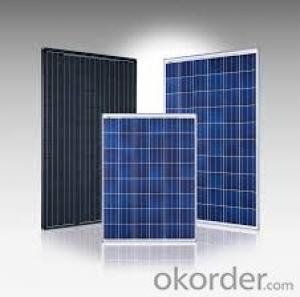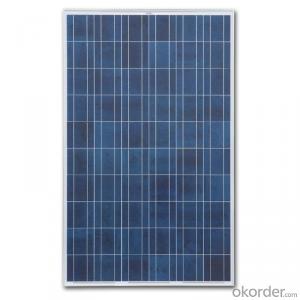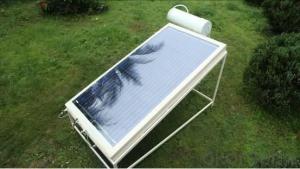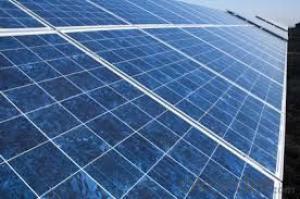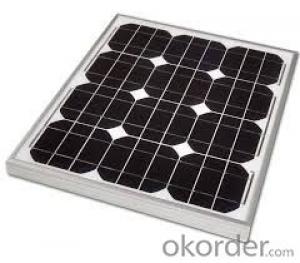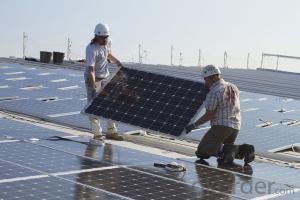Pre-Tabbed Solar Cells Factory Direct Sale Polycrystalline Solar Panel CNBM
- Loading Port:
- Qingdao
- Payment Terms:
- TT OR LC
- Min Order Qty:
- 10 set
- Supply Capability:
- 300000 set/month
OKorder Service Pledge
OKorder Financial Service
You Might Also Like
Polycrystalline Solar Modules
CNBM offers a range of small, medium and large polycrystalline solar modules, designed for a range of requirements.
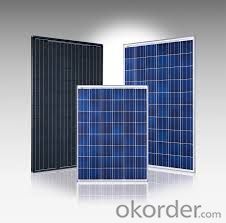
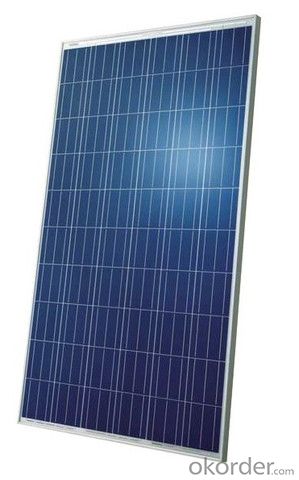
Specifications:
Tolerance | +/-3% |
Cell | Polycrystalline silicon solar cells (156 x 156mm) |
N0. of Cells | 60 (10 x 6) |
Dimension of Modules (mm) | 1650 x 990 x 40 |
Weight (kg) | 25.5 |
Limits:
Operating Temperature | -40~+85? |
Storage Temperature | -40~+85? |
Maximum System Voltage | 1000 VDC max. |
Hail Impact | Diameter of 28mm with impact speed |
Temperature and Coefficients:
NOCT | 48C+/-2? |
Voltage temperature coefficient (%/K) | -0.35 |
Current temperature coefficient (%/K) | 0.05 |
Power temperature coefficient (%/K) | -0.45 |
Characteristics:
Model: | SGM-200P | SGM-210P | SGM-220P |
Max-power voltage Vmp (V) | 29.2 | 29.4 | 29.41 |
Max-power current Imp (A) | 6.85 | 7.14 | 7.48 |
Open-circuit voltage Voc (V) | 36.5 | 36.69 | 36.9 |
Short-Circuit Current Isc (A) | 7.28 | 7.6 | 7.93 |
Max-power Pm(W) | 200 | 210 | 220 |
Model: | SGM-230P |
Max-power voltage Vmp (V) | 29.8 |
Max-power current Imp (A) | 7.72 |
Open-circuit voltage Voc (V) | 37.31 |
Short-Circuit Current Isc (A) | 8.19 |
Max-power Pm(W) | 230 |
STC: Irradiance 1000W/m2, module temperature 25?, AM-=1.5
Poly Crystalline Solar Panels Specifications Range
Maximum Power (Pm) | Dimension | Weight | Operating Voltage (Vmp) | Operating Current (Imp) | Open Circuit Voltage (Voc) | Short Circuit Current (Isc) |
0.45W | 140x80x10mm | 0.08kg | 3.3V | 150mA | 4.6V | 160mA |
1.0W | 162x140x10mm | 0.16kg | 7.5V | 150mA | 10.3V | 160mA |
4.5W | 269x251x23mm | 0.8kg | 16.5V | 0.27A | 20.5V | 0.3A |
10W | 420.1×268.9×22.6mm | 1.92kg | 17.5V | 0.58A | 20.5V | 0.6A |
20W | 425x502x50mm | 3.0kg | 16.8V | 1.19A | 21.0V | 1.29A |
30W | 593x502x22.6mm | 3.9kg | 16.8V | 1.78A | 21.0V | 1.94A |
40W | 655x537x50mm | 5.75kg | 17.3V | 2.31A | 22.1V | 2.54A |
50W | 839x537x50mm | 6.0kg | 17.5V | 2.9A | 21.8V | 3.17A |
65W | 1111x502x50mm | 7.2kg | 17.6V | 3.69A | 22.1V | 3.99A |
80W | 1204x537x50mm | 7.7kg | 17.6V | 4.55A | 22.1V | 4.8A |
- Q: Can solar cells be used for powering water treatment plants?
- Yes, solar cells can be used for powering water treatment plants. Solar energy can be harnessed and converted into electricity to power the various processes and equipment required for water treatment. This renewable energy source offers a sustainable and environmentally friendly solution for powering water treatment plants.
- Q: Can solar cells be used in camping or outdoor recreational activities?
- Yes, solar cells can be used in camping or outdoor recreational activities. They are a convenient and environmentally friendly way to generate electricity in remote locations where power outlets may not be available. Solar panels can be used to charge portable devices such as phones, laptops, or camping lights, providing a sustainable source of energy while enjoying outdoor activities.
- Q: How do solar cells handle snow or ice buildup?
- Solar cells do not handle snow or ice buildup well as they rely on sunlight to generate electricity. When covered with snow or ice, solar cells are unable to effectively convert sunlight into energy. However, some solar panels are designed with a tilt or smooth surface to help the snow slide off easily, and in certain cases, heating elements or manual cleaning may be used to remove snow or ice from the surface of the cells.
- Q: Can solar cells be used to power irrigation systems?
- Yes, solar cells can be used to power irrigation systems. Solar cells convert sunlight into electricity, which can be stored in batteries and used to power irrigation systems. This provides a sustainable and renewable energy source for agriculture and reduces dependency on traditional power grids.
- Q: What is the effect of pollution on solar cell performance?
- The effect of pollution on solar cell performance is negative. Pollution, such as dust, smog, and air pollutants, can accumulate on the surface of solar panels, reducing their ability to absorb sunlight and convert it into electricity. This build-up of pollution creates a barrier between the sun and the solar cells, resulting in a decrease in their overall efficiency and power output. Regular cleaning and maintenance of solar panels are necessary to minimize the impact of pollution and ensure optimal performance.
- Q: How do solar cells impact energy independence?
- Solar cells impact energy independence by harnessing the power of the sun to generate electricity, reducing reliance on traditional fossil fuels. By providing a clean and renewable source of energy, solar cells contribute to reducing greenhouse gas emissions and increasing energy self-sufficiency, ultimately enhancing a country's energy independence.
- Q: Can solar cells be used in off-grid applications?
- Yes, solar cells can definitely be used in off-grid applications. Off-grid systems rely on solar energy to generate electricity, making solar cells an ideal and sustainable solution for powering remote locations, cabins, boats, and other off-grid setups. Solar cells capture sunlight and convert it into electrical energy, which can then be stored in batteries for use during periods of low or no sunlight. With advancements in technology, solar cells have become more efficient and affordable, making them a practical choice for off-grid applications.
- Q: I am working on research for the usage of solar cells, where can I find more news of solar cells?
- You can visit the city library, where you can find a lot of books and newspapers talking about the solar cells.
- Q: Do solar cells work at night or in low light conditions?
- No, solar cells do not work at night or in low light conditions as they rely on sunlight to generate electricity.
- Q: Can solar cells be used in extreme climates?
- Yes, solar cells can be used in extreme climates. While extreme temperatures and harsh weather conditions can affect their efficiency to some extent, solar cells are designed to withstand a wide range of climates. In fact, many solar installations are successfully operating in extreme environments such as deserts, polar regions, and high-altitude areas. Proper design, installation, and maintenance techniques can ensure their optimal performance and durability even in challenging climate conditions.
Send your message to us
Pre-Tabbed Solar Cells Factory Direct Sale Polycrystalline Solar Panel CNBM
- Loading Port:
- Qingdao
- Payment Terms:
- TT OR LC
- Min Order Qty:
- 10 set
- Supply Capability:
- 300000 set/month
OKorder Service Pledge
OKorder Financial Service
Similar products
Hot products
Hot Searches
Related keywords
